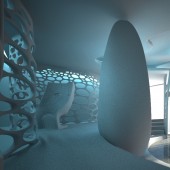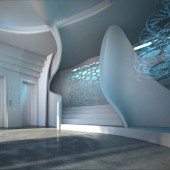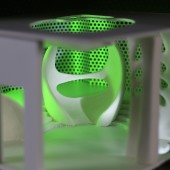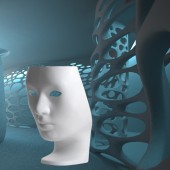
| THE AWARD |
| CATEGORIES |
| REGISTRATION |
| SUBMIT YOUR WORK |
| ENTRY INSTRUCTIONS |
| TERMS & CONDITIONS |
| PUBLICATIONS |
| DATES & FEES |
| METHODOLOGY |
| CONTACT |
| WINNERS |
| PRESS ROOM |
| GET INVOLVED |
| DESIGN PRIZE |
| DESIGN STORE |
| THE AWARD | JURY | CATEGORIES | REGISTRATION | PRESS | WINNERS | PUBLICATIONS | ENTRY INSTRUCTIONS |
Pharmacy Gate 4d Corporate Architecture Concept by Peter Stasek |
Home > Winners > Design #30260 >Interview |
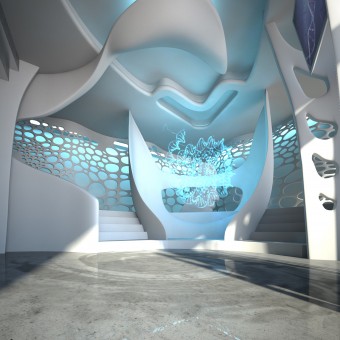 |
|
FS: What is the main principle, idea and inspiration behind your design?
PS: The project “Pharmacy Gate 4D” represents an intermediary architectural concept for the entrance hall of the German branch of a global US-based pharmaceutical company. “Pharmacy Gate 4D” was created in dependence on the company slogan „A Promise for Life“ and thus is able to express this company feature in the form of corporate architecture, amongst others with the aid of holographic projection.
FS: What has been your main focus in designing this work? Especially what did you want to achieve?
PS: The creative concept is based on the combination of material and immaterial components, which together create a media platform. The centre point of this platform is characterized by an oversized bowl as a symbol for an abstract alchemy goblet above which a holographic diagram of a floating DNA strand is projected. This DNA hologram, which in fact represents the slogan „A Promise for Life“, rotates slowly and suggests the easiness of life of a symptom-free human organism. The rotating DNA hologram not only represents the flow of life but also the relationship between light and life itself. In the background of this bowl, an additional symbol of human life appears, a human face in the form of the 3D sculpture „Nemo“. This scenario is framed by organically shaped wall coverings with perforations in the form of abstract organic structures.
FS: What are your future plans for this award winning design?
PS: The basic idea of this concept is based on the connection between the material and immaterial components. Here holography serves as a continuation of the already materialized forms into the virtual. All parts should be perceived as an inseparable whole.
FS: How long did it take you to design this particular concept?
PS: About three months.
FS: Why did you design this particular concept? Was this design commissioned or did you decide to pursuit an inspiration?
PS: The design was commissioned by ABBOTT Germany.
FS: Is your design being produced or used by another company, or do you plan to sell or lease the production rights or do you intent to produce your work yourself?
PS: Until today this concept has been developed by us only for the company ABBOTT.
FS: What made you design this particular type of work?
PS: ABBOTT is one of the largest medical companies in the world with enormous development potential. The slogan of the company "A Promise for Life", stands for all innovative solutions that help people lead a fulfilling life. This type of research is shown in our design in the form of an abstracted cup with a rotating holograph of a DNA strand above it.
FS: Where there any other designs and/or designers that helped the influence the design of your work?
PS: With the development of holography design have helped: Mr. Alexey Porollo, Department of Environmental Health, University of Cincinnati, USA Mrs. Linda Law, Executive Director of the Center for 4D Arts, New York, USA
FS: Who is the target customer for his design?
PS: Medical institutes, Laboratories, Hospitals.
FS: What sets this design apart from other similar or resembling concepts?
PS: The use of holography as part of the interior of a lobby.
FS: How did you come up with the name for this design? What does it mean?
PS: "Pharmacy Gate 4D" represents the continuous transition from the tangible (already existing) to the imaginary world of future developments.
FS: Which design tools did you use when you were working on this project?
PS: imagation drawings physical model ArchiCAD 3dsMax Photoshop
FS: What is the most unique aspect of your design?
PS: There is no limit between the tangible and the intangible.
FS: Who did you collaborate with for this design? Did you work with people with technical / specialized skills?
PS: Mr. Alexey Porollo, Department of Environmental Health, University of Cincinnati, USA Mrs. Linda Law, Executive Director of the Center for 4D Arts, New York, USA
FS: What is the role of technology in this particular design?
PS: 3d printing the latest developments in holography
FS: Is your design influenced by data or analytical research in any way? What kind of research did you conduct for making this design?
PS: Collaboration with Department of Environmental Health, University of Cincinnati, USA
FS: What are some of the challenges you faced during the design/realization of your concept?
PS: The coordination between 3d printing and holography
FS: How did you decide to submit your design to an international design competition?
PS: To show new ways in an interior design.
FS: What did you learn or how did you improve yourself during the designing of this work?
PS: Learned a lot about the types of holography.
FS: Thank you for providing us with this opportunity to interview you.
A' Design Award and Competitions grants rights to press members and bloggers to use parts of this interview. This interview is provided as it is; DesignPRWire and A' Design Award and Competitions cannot be held responsible for the answers given by participating designers.
| SOCIAL |
| + Add to Likes / Favorites | Send to My Email | Comment | View Press-Release | Translations |
